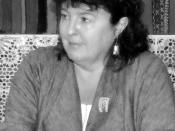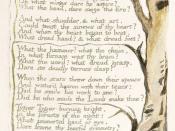English Course Work
Jamie Fernback
Analyse The Ways in which fear and fearful situations are presented in the poems you have chosen
Fear and fearful situations are very prominent in the six poems I have chosen. Although they may be expressed in different ways and contexts, they seem to link together. I will be looking at the content and poetic language, comparing the poems as I progress.
Fear of the world, creation and society is a very strong and bold theme is the poems I have studied. "Do not go gentle into that good night" by Dylan Thomas explores the fear of death and not fulfilling hopes. "Burn and rave at the close of day", this implies that when you are in your dying hours be unrestrained and not hold back. The end of life being near is implied, in the reference to the "dying of the light". The choice of the word "Burn" suggests that the person is in a sense of torture, or even a sense of hell.
It's as if Thomas is pleading to someone not to give in, he wants him or her to go out with a swansong. The dichotomy between "blaze like meteors", showing signs of life as they require so much energy, and "blind eyes" which shows death as if the body is dying itself and its functions are shutting down, this shows that life has two sides that are separate, energy of life and the fatal position of death. The idea of a swan song is furthered, "rage, rage against the dying of the light", you need to go out with a bang. "Do not go gentle" is Thomas' plea that he die fighting for life, instead of being weak in the face of death go fearlessly and don't succumb.
There is a sense of awe and fear in "The Tyger" by William Blake. " In what distant depths or skies burnt the fire of thine eyes", shows that it's frightening that creation can spark from a vast emptiness, a void, and "distant depths". The spark of this energy comes into the " fire of thine eyes". The act of creation involves a fearsome strength and the mention by Blake of "dread hands" and "dread feet" shows that there is an omnipresent fear, a great fear, of what could happen. "Grasp" and "clasp!" shows that God or a God-like creature needs to work hard to harness such dangerous energy. The extended metaphor of him being a blacksmith, "what the hammer?" "In what furnace?" & "what the anvil?" shows the strength and energy of this creation. This makes you have the emotion of awe; we respect the creator but also fear them due the amount of energy they harness. "Forests of the night" is another unsettling image used by Blake At one level this can be seen as a nightmare image of a forest but this could also be the same fear of emptiness as mention above. This fear created in the face of divine strength is clever as a tiger in itself is a fearful creature.
Fear of death as explored in Dylan Thomas' "Do not go gentle" is also explored in "War Photographer" by Carol Ann Duffy although in this poem, the theme is tackled indirectly through the aftermath of war. Although the photojournalist is producing the photos for the public, he faces the horror of the war "alone" in the darkroom. This sense of isolation is furthered later on in the poem as "his editor will pick out five or six" showing that the editor is only interested in the most engaging pictures and not what the people there would have felt at that moment of time. Also this happens when talking about the readers, "reader's eyeballs prick with tears between the bath and pre lunch beers"; it shows the readers acknowledge the horror of war but its only for a limited time "between the bath and pre lunch beers". The developing process of the photos perhaps engages the fear of death. When the pictures were taken he didn't have the chance to see how they looked, he waits what emerges from the "spools of suffering". This use of sibilance emphases the pain Carol Ann Duffy wanted the reader to acknowledge. There is also an extended metaphor to describe the whole process as if it is as if it's a mass. This is because the whole process is like the sacred and solemn act of mass. It also helps him control the chaos and the horror of war as he can do it in an ordered manner. But his emotions do break through, as the images appear on the photographic paper a "half formed ghost".
As in "The Tyger" by William Blake, "La Belle Dame sans Merci" by John Keats also explores the fear of something bigger and the super natural. The medieval and mythical setting of the poem adds to a feeling of eeriness in the atmosphere. "O what can ail thee" shows that there is something wrong with the "knight at arms" who should be noble and strong. The way Keats uses a pathetic fallacy straight away in the first stanza is very clever, the Knight seems to be weak "palely loitering" and "sedge has withered" showing its dying or ill too. The constant mention of illness causes the sense to become foreboding and ominous, we learn he is "haggard and so woe begone". It seems that the Knight is worn out and furrowed in pain "haggard". The image of him acting "paley" is furthered as he is also described as having a "lilyâ¦brow". He also comes to be ill, "anguish moist and fever-dew" he seems to being sweating as implied my "anguish moist". The drops of sweat are like morning "dew". The illness is extended "thy cheek a fading rose", which shows his colour is fading from his face. The medieval theme is carried on as the mention of "lily" has chivalric connotations, as the Fleur de Lys is associated with French chivalric literature. The embedded narrative in stanza 4 of the ballad is where the Knight begins to tell his tale "I met a lady". "Faery's child" links back to its archaic setting of the poem. The description that her "eyes were wild" shows she is a nature spirit. As he tried to court her she seemed to reciprocate "looked at me as she did love me". "I set her on my pacing steed", is a sign that the relationship is still positive and that the Knight is still positive and decisive. A fear of God also appears in "La Belle Dame sans Merci" as it did in "The Tyger". The forbidden fruit perhaps is hinted at in the mention of "manna" which is the fruit from heaven. "Language strange" is expressing through the biblical association that he is becoming hypnotised by her it is almost intoxicating. The idea of him being hypnotised is shown "lulled me asleep" and then "I awoke and found me here", he has fallen asleep then she leaves and he awakes alone. His dreams of an underworld, comparable to that in Homer's Odyssey; there he meets others that have fallen and become trapped in her "thrall". His fear that previously was eliminated returns she does not actually love him, but she is motirelesly malignant.
"My Last Duchess" by Robert Browning explores a fear of oppression and being oppressed. While the newly widowed Duke shows round an ambassador around his gallery to arrange a marriage to a daughter of very powerful and rich family, he comes to a halt at a portrait of his late wife. She appears to be a good-looking young woman. This image is suddenly shattered as the duke begins to reminisce that she did not appreciate his "gift of a nine-hundred-years- old name." Her was clearly ordered by the Duke "[he] gave demandsâ¦. all smiles stopped together". It is as if the Duke is sat in a councillor's office and he is flowing, he is saying in detail what he feels about his late wife and all the problems she seemed to cause. "Just this, or that in you disgusts me; here you miss, or there exceed the mark" the Duke's sanity becomes questioned. The inappropriate use of this word makes you think about other ways in which the Duke can be inappropriate. This pointed is further emphasised by his explanation that if the duchess did something he did not like he would find a new duchess. The fear is of someone being greater than yourself is, jealously. This features very strongly in "My Last Duchess" as the duke was clearly jealous of his late wife. "Such stuff was courtesy, she thought, and cause enough for her to call up that spot of joy", the Duke believes that the duchess only blushes to compliments when it suits her at compliments. "Call up" is the idea that its voluntary and she makes the decision. But as a reader we can see that the duke's jealously is irrational, and that the blushes are just a natural reaction.
The fear of the evil of human society is prevalent in "Prayer Before Birth" by Louis MacNeice. One major theme is that the world is a cruel and dangerous place " I fear⦠the human race". "I am not yet born yet" at the start of each stanza gives the reader an idea that the poem is like a prayer "forgive me", asking forgiveness for sins. Emphasis on the fact that the child isn't even born yet, he has an adult conscience and understands the danger and troubles of the world, creating an ominous tone to the poem. After the start of each stanza there follows a plea from the child by the use of an imperative. The first stanza expresses fear through use alliteration in "blood sucking bat", which is an image of horror; even the mind of an unborn seems to have become corrupted. "Drugs dope" shows us the child understands the danger some humans can be to us. A strong feeling of claustrophobia is created by use of internal repetition "tall walls wall me" and "black racks rack me", illustrating the hopelessness of escaping the corruption and danger mentioned throughout the poem. There is then created a hint of optimism in what life holds, "sky to sing to me", the soft sound created by the sibilance is much softer than the alliteration used in "drugs dope me" and the imagery shows hope. MacNeice's use of personification throughout the poem is clever as it shows the child wishes to stay in harmony with nature "the desert calls". This feeling of fear of humans, and the destruction which can be caused by humans, will link with the period in which it was written. As, in 1944, Britain was being bombed in the Second World War. "Forgive me" shows that the child is already acknowledging that it will inevitably sin as a cause of human nature and society. "White waves call me to folly" shows that even nature may become harmful, which shows the impossibility of someone being able to stay innocent and pure forever. "White" the colour that is normally a sign of peace and innocence, is now linked with the potential danger that the child will face, MacNeice's use of irony is very well thought out.
1


